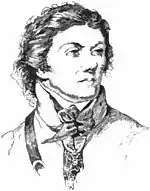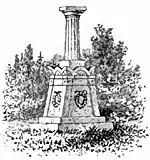KOSCIUSZKO, Tadeusz (Thaddeus) (kos-se-us'-ko),
Polish patriot, b. near Novogrudek, Lithuania,
12 Feb., 1746; d. in Solothurn, Switzerland, 15 Oct., 1817. He was descended from a noble
Lithuanian family, studied at the military academy
of Warsaw, and, completing his education in
France at the expense of the state, returned to
Poland, entered the army, and rose to the rank of
captain. An unrequited passion for the daughter
of the Marquis of Lithuania induced him to leave

![]() Poland in 1775 and
offer his assistance
to the Americans in
their war for
independence. The
number of foreign
auxiliary officers
had become numerous,
and Washington
had complained
to congress, in
October, 1776, that he
was unable to
employ many of them,
owing to their
ignorance of English.
Kosciuszko,
however, arrived with
letters of
recommendation from
Benjamin Franklin
to Washington, who inquired what he could do.
“I come to fight as a volunteer for American
independence,” answered Kosciuszko. “What can
you do?” asked Washington. “Try me,” was the
reply. He received his commission as a colonel of
engineers on 18 Oct., 1776, and repaired to his
post with the troops under Gen. Gates, who
described him as “an able engineer, and one of the
best and neatest draughtsmen that he ever saw,”
and selected him for the northern service, ordering
him, “after he had made himself thoroughly
acquainted with the works, to point out where and
in what manner the best improvements and additions
could be made thereto.” Kosciuszko therefore
planned the encampment and post of Gates's
army at Bemis Heights, near Saratoga, from
which, after two well-fought actions, Burgoyne
found it impossible to dislodge the Americans.
Kosciuszko was subsequently the principal engineer
in executing the works at West Point. He
became one of Washington's adjutants, and aided
Gen. Nathanael Greene in the unsuccessful siege of
Ninety-Six, receiving for his services the thanks
of congress and the brevet of brigadier-general,
13 Oct., 1783. One of Washington's latest
official acts was to intercede with congress for the
bestowal of these honors. He was also made a
member of the Society of the Cincinnati. At the
end of the war he returned to Poland, where he
lived several years in retirement. When the Polish
army was reorganized in 1789, he was appointed a
major-general, and fought in defence of the
constitution of 3 May, 1791, under Prince Poniatowski,
against the Russians. He was in the battle of
Zielence, 18 June, 1792, and in that of Dubienka,
17 July, 1792, where, with only 4,000 men, he kept
15,000 Russians at bay for six hours, making his
retreat without great loss. But the patriots
were overwhelmed by numbers, and when King
Stanislas submitted to the second partition of
Poland, Kosciuszko resigned his commission and
retired to Leipsic, where he received from the
national assembly the citizenship of France. He
determined to make a second effort for Poland, and
a rising of his countrymen was secretly planned.
Kosciuszko was elected dictator and general-in-chief.
On 24 March, 1794, he suddenly appeared
in Cracow, issued a manifesto against the Russians,
and hastily collected a force of about 5,000 peasants,
armed mostly with scythes. At Raclawice he
routed a Russian corps that was almost twice as
strong, and returned in triumph to Cracow. He
committed the conduct of government affairs to a
national council that was organized by himself,
and after receiving re-enforcements moved
forward in quest of the Russian army. The march
was opposed by the king of Prussia at the head of
40,000 men, and Kosciuszko, whose force was only
13,000, was defeated at Szczekociny, 6 June, 1794.
Unable to check the prevailing anarchy, Kosciuszko
resigned his dictatorship and retired with his
army to Warsaw, and defended it against the
Prussians and Russians, whom he compelled to
raise the siege. Austria now took part against
him with 150,000 men, and he was routed at
Maciejowice, 10 Oct., 1794. Kosciuszko fell covered
with wounds. He was imprisoned in St. Petersburg
for two years, until the death of Catherine,
when the Emperor Paul gave him his liberty, with
many marks of esteem. The czar, in releasing
him, offered him his sword, but Kosciuszko refused
to accept it, saying, “I have no need of a sword;
I have no country to defend.” Subsequently his
countrymen in the French army of Italy presented
him with the sword of John Sobieski. On crossing
the Russian frontier he returned to the czar the
patent of his pension and every testimonial of
Russian favor, and passed the rest of his life in retirement.
He visited the United States in 1797, where
he was received with distinction, and obtained from
congress a grant of land, in addition to the pension
that he had received after the Revolutionary
war. He then resided in Fontainebleau until 1814,
engaged in agriculture. When Napoleon was
about to invade Poland in 1806 he wished to
employ Kosciuszko, who, being under parole not to
fight against Russia, refused to enlist, and the
proclamation to the Poles that appeared in the
“Moniteur” under his name in 1806 he declared
to be a forgery. In 1816 he removed to Solothurn,
Switzerland, and in the following year sent a deed
of manumission to all the serfs on his Polish
estate. His death was caused by a fall from his
horse over a precipice. The Emperor Alexander
Poland in 1775 and
offer his assistance
to the Americans in
their war for
independence. The
number of foreign
auxiliary officers
had become numerous,
and Washington
had complained
to congress, in
October, 1776, that he
was unable to
employ many of them,
owing to their
ignorance of English.
Kosciuszko,
however, arrived with
letters of
recommendation from
Benjamin Franklin
to Washington, who inquired what he could do.
“I come to fight as a volunteer for American
independence,” answered Kosciuszko. “What can
you do?” asked Washington. “Try me,” was the
reply. He received his commission as a colonel of
engineers on 18 Oct., 1776, and repaired to his
post with the troops under Gen. Gates, who
described him as “an able engineer, and one of the
best and neatest draughtsmen that he ever saw,”
and selected him for the northern service, ordering
him, “after he had made himself thoroughly
acquainted with the works, to point out where and
in what manner the best improvements and additions
could be made thereto.” Kosciuszko therefore
planned the encampment and post of Gates's
army at Bemis Heights, near Saratoga, from
which, after two well-fought actions, Burgoyne
found it impossible to dislodge the Americans.
Kosciuszko was subsequently the principal engineer
in executing the works at West Point. He
became one of Washington's adjutants, and aided
Gen. Nathanael Greene in the unsuccessful siege of
Ninety-Six, receiving for his services the thanks
of congress and the brevet of brigadier-general,
13 Oct., 1783. One of Washington's latest
official acts was to intercede with congress for the
bestowal of these honors. He was also made a
member of the Society of the Cincinnati. At the
end of the war he returned to Poland, where he
lived several years in retirement. When the Polish
army was reorganized in 1789, he was appointed a
major-general, and fought in defence of the
constitution of 3 May, 1791, under Prince Poniatowski,
against the Russians. He was in the battle of
Zielence, 18 June, 1792, and in that of Dubienka,
17 July, 1792, where, with only 4,000 men, he kept
15,000 Russians at bay for six hours, making his
retreat without great loss. But the patriots
were overwhelmed by numbers, and when King
Stanislas submitted to the second partition of
Poland, Kosciuszko resigned his commission and
retired to Leipsic, where he received from the
national assembly the citizenship of France. He
determined to make a second effort for Poland, and
a rising of his countrymen was secretly planned.
Kosciuszko was elected dictator and general-in-chief.
On 24 March, 1794, he suddenly appeared
in Cracow, issued a manifesto against the Russians,
and hastily collected a force of about 5,000 peasants,
armed mostly with scythes. At Raclawice he
routed a Russian corps that was almost twice as
strong, and returned in triumph to Cracow. He
committed the conduct of government affairs to a
national council that was organized by himself,
and after receiving re-enforcements moved
forward in quest of the Russian army. The march
was opposed by the king of Prussia at the head of
40,000 men, and Kosciuszko, whose force was only
13,000, was defeated at Szczekociny, 6 June, 1794.
Unable to check the prevailing anarchy, Kosciuszko
resigned his dictatorship and retired with his
army to Warsaw, and defended it against the
Prussians and Russians, whom he compelled to
raise the siege. Austria now took part against
him with 150,000 men, and he was routed at
Maciejowice, 10 Oct., 1794. Kosciuszko fell covered
with wounds. He was imprisoned in St. Petersburg
for two years, until the death of Catherine,
when the Emperor Paul gave him his liberty, with
many marks of esteem. The czar, in releasing
him, offered him his sword, but Kosciuszko refused
to accept it, saying, “I have no need of a sword;
I have no country to defend.” Subsequently his
countrymen in the French army of Italy presented
him with the sword of John Sobieski. On crossing
the Russian frontier he returned to the czar the
patent of his pension and every testimonial of
Russian favor, and passed the rest of his life in retirement.
He visited the United States in 1797, where
he was received with distinction, and obtained from
congress a grant of land, in addition to the pension
that he had received after the Revolutionary
war. He then resided in Fontainebleau until 1814,
engaged in agriculture. When Napoleon was
about to invade Poland in 1806 he wished to
employ Kosciuszko, who, being under parole not to
fight against Russia, refused to enlist, and the
proclamation to the Poles that appeared in the
“Moniteur” under his name in 1806 he declared
to be a forgery. In 1816 he removed to Solothurn,
Switzerland, and in the following year sent a deed
of manumission to all the serfs on his Polish
estate. His death was caused by a fall from his
horse over a precipice. The Emperor Alexander
 had him interred
beside Poniatowski and
Sobieski in the cathedral
of Cracow, near
which city the people
raised to his memory
a mound 150 feet high,
the earth of which was
brought from every
great battle-field of
Poland. From a fancied
resemblance to
this mound the loftiest
mountain in Australia
has received the
name of Mount
Kosciuszko. A monument
of white marble, designed by John H. B. Latrobe,
and represented in the illustration, was erected to
his memory at West Point by the U. S. military
academy cadet corps of 1828, at a cost of $5,000.
See Chodzko's “Histoire militaire, politique et
privée de Kosciuszko” (Paris, 1837); and
Falkenstein's “Leben Kosciuszko's” (Leipsic, 1825).
had him interred
beside Poniatowski and
Sobieski in the cathedral
of Cracow, near
which city the people
raised to his memory
a mound 150 feet high,
the earth of which was
brought from every
great battle-field of
Poland. From a fancied
resemblance to
this mound the loftiest
mountain in Australia
has received the
name of Mount
Kosciuszko. A monument
of white marble, designed by John H. B. Latrobe,
and represented in the illustration, was erected to
his memory at West Point by the U. S. military
academy cadet corps of 1828, at a cost of $5,000.
See Chodzko's “Histoire militaire, politique et
privée de Kosciuszko” (Paris, 1837); and
Falkenstein's “Leben Kosciuszko's” (Leipsic, 1825).